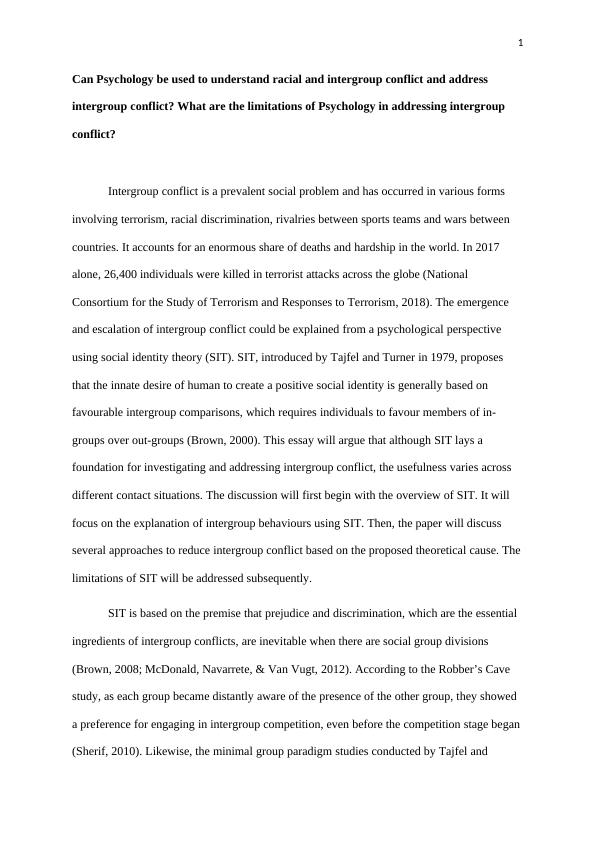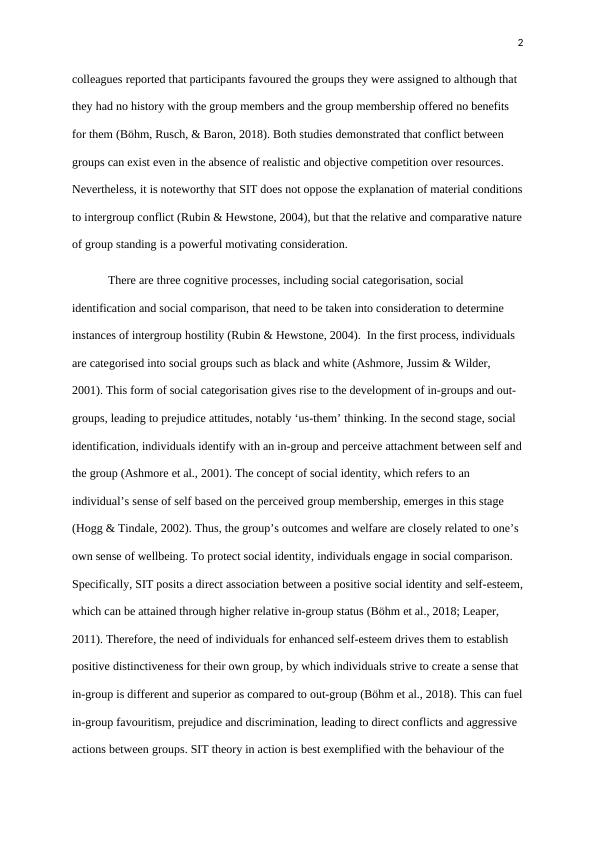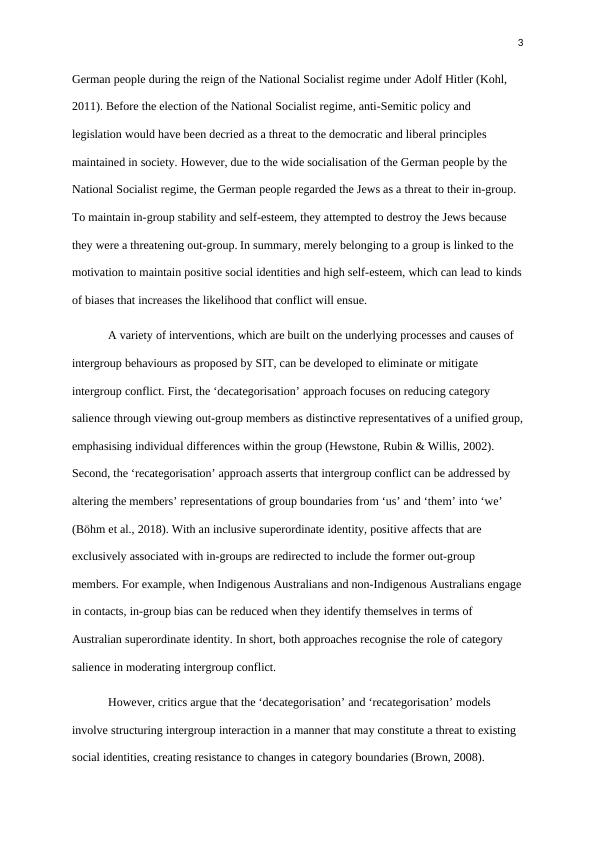Can Psychology be used to address intergroup conflict? 5 Can Psychology be used to address intergroup conflict?
Added on 2021-01-06
9 Pages2680 Words445 Views
1Can Psychology be used to understand racial and intergroup conflict and address intergroup conflict? What are the limitations of Psychology in addressing intergroup conflict? Intergroup conflict is a prevalent social problem and has occurred in various forms involving terrorism, racial discrimination, rivalries between sports teams and wars between countries. It accounts for an enormous share of deaths and hardship in the world. In 2017 alone, 26,400 individuals were killed in terrorist attacks across the globe (National Consortium for the Study of Terrorism and Responses to Terrorism, 2018). The emergence and escalation of intergroup conflict could be explained from a psychological perspective using social identity theory (SIT). SIT, introduced by Tajfel and Turner in 1979, proposes that the innate desire of human to create a positive social identity is generally based on favourable intergroup comparisons, which requires individuals to favour members of in-groups over out-groups (Brown, 2000). This essay will argue that although SIT lays a foundation for investigating and addressing intergroup conflict, the usefulness varies across different contact situations. The discussion will first begin with the overview of SIT. It will focus on the explanation of intergroup behaviours using SIT. Then, the paper will discuss several approaches to reduce intergroup conflict based on the proposed theoretical cause. Thelimitations of SIT will be addressed subsequently.SIT is based on the premise that prejudice and discrimination, which are the essential ingredients of intergroup conflicts, are inevitable when there are social group divisions (Brown, 2008; McDonald, Navarrete, & Van Vugt, 2012). According to the Robber’s Cave study, as each group became distantly aware of the presence of the other group, they showed a preference for engaging in intergroup competition, even before the competition stage began (Sherif, 2010). Likewise, the minimal group paradigm studies conducted by Tajfel and

2colleagues reported that participants favoured the groups they were assigned to although that they had no history with the group members and the group membership offered no benefits for them (Böhm, Rusch, & Baron, 2018). Both studies demonstrated that conflict between groups can exist even in the absence of realistic and objective competition over resources. Nevertheless, it is noteworthy that SIT does not oppose the explanation of material conditionsto intergroup conflict (Rubin & Hewstone, 2004), but that the relative and comparative natureof group standing is a powerful motivating consideration. There are three cognitive processes, including social categorisation, social identification and social comparison, that need to be taken into consideration to determine instances of intergroup hostility (Rubin & Hewstone, 2004). In the first process, individuals are categorised into social groups such as black and white (Ashmore, Jussim & Wilder, 2001). This form of social categorisation gives rise to the development of in-groups and out-groups, leading to prejudice attitudes, notably ‘us-them’ thinking. In the second stage, social identification, individuals identify with an in-group and perceive attachment between self andthe group (Ashmore et al., 2001). The concept of social identity, which refers to an individual’s sense of self based on the perceived group membership, emerges in this stage (Hogg & Tindale, 2002). Thus, the group’s outcomes and welfare are closely related to one’s own sense of wellbeing. To protect social identity, individuals engage in social comparison. Specifically, SIT posits a direct association between a positive social identity and self-esteem,which can be attained through higher relative in-group status (Böhm et al., 2018; Leaper, 2011). Therefore, the need of individuals for enhanced self-esteem drives them to establish positive distinctiveness for their own group, by which individuals strive to create a sense that in-group is different and superior as compared to out-group (Böhm et al., 2018). This can fuelin-group favouritism, prejudice and discrimination, leading to direct conflicts and aggressive actions between groups. SIT theory in action is best exemplified with the behaviour of the

3German people during the reign of the National Socialist regime under Adolf Hitler (Kohl, 2011). Before the election of the National Socialist regime, anti-Semitic policy and legislation would have been decried as a threat to the democratic and liberal principles maintained in society. However, due to the wide socialisation of the German people by the National Socialist regime, the German people regarded the Jews as a threat to their in-group. To maintain in-group stability and self-esteem, they attempted to destroy the Jews because they were a threatening out-group.In summary, merely belonging to a group is linked to the motivation to maintain positive social identities and high self-esteem, which can lead to kindsof biases that increases the likelihood that conflict will ensue.A variety of interventions, which are built on the underlying processes and causes of intergroup behaviours as proposed by SIT, can be developed to eliminate or mitigate intergroup conflict. First, the ‘decategorisation’ approach focuses on reducing category salience through viewing out-group members as distinctive representatives of a unified group,emphasising individual differences within the group (Hewstone, Rubin & Willis, 2002). Second, the ‘recategorisation’ approach asserts that intergroup conflict can be addressed by altering the members’ representations of group boundaries from ‘us’ and ‘them’ into ‘we’ (Böhm et al., 2018). With an inclusive superordinate identity, positive affects that are exclusively associated with in-groups are redirected to include the former out-group members. For example, when Indigenous Australians and non-Indigenous Australians engagein contacts, in-group bias can be reduced when they identify themselves in terms of Australian superordinate identity. In short, both approaches recognise the role of category salience in moderating intergroup conflict. However, critics argue that the ‘decategorisation’ and ‘recategorisation’ models involve structuring intergroup interaction in a manner that may constitute a threat to existing social identities, creating resistance to changes in category boundaries (Brown, 2008).

End of preview
Want to access all the pages? Upload your documents or become a member.
